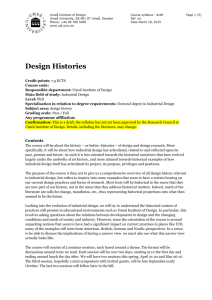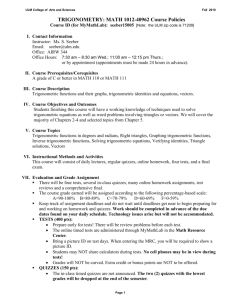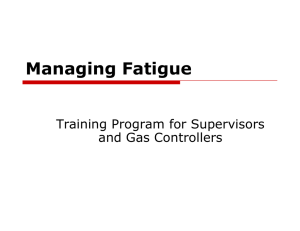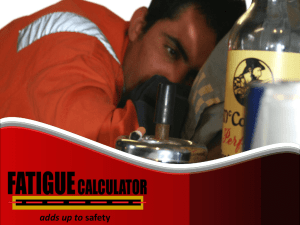ULM School of Nursing Faculty & Staff Assessment
advertisement
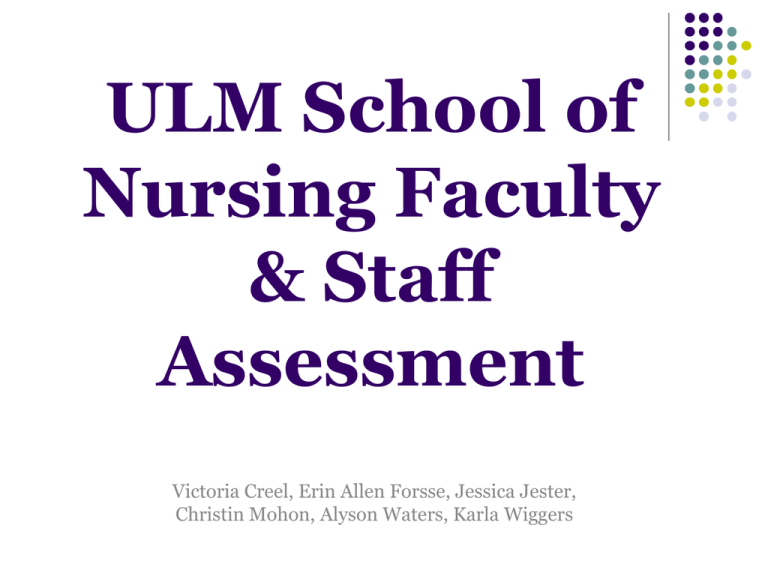
ULM School of Nursing Faculty & Staff Assessment Victoria Creel, Erin Allen Forsse, Jessica Jester, Christin Mohon, Alyson Waters, Karla Wiggers HEALTH SEEKING BEHAVIORS Jessica Jester Rationale Surveys showed a desire to gain more knowledge regarding Zumba, bike riding, and the availability of canoes. Benefits of exercise Improve your mood Helps fight diseases Promotes better sleep Goal The SON faculty & staff will identify resources available in their community regarding exercise programs and lifestyle activities. Objectives Identify convenient resources for exercise State where canoes can be obtained Identify what Zumba is and where to find a class State where one can join a group for bike riding What Nursing Students Can Do Provide information regarding the University of Louisiana at Monroe (ULM) Activity Center and Natatorium with hours of operation and classes offered. Provide information about the Human Performance Lab within the ULM Kinesiology Department Provide information about local health and wellness resources. ULM Activity Center Hours of operation: Monday thru Thursday 6AM to 9PM Friday 6AM to 8PM Saturday and Sunday 1PM to 7PM Classes offered: Butts & Guts, Cardio Kick, Total Training, Core, Pilates, Pump & Jump, Sculpt, Crossfit, Zumba Treadmills, elliptical machines, stationary bikes, rowing machines, free weights, inside track, basketball / volleyball court, 6 racketball rooms, steam room, locker room, showers ULM Activity Center ULM Natatorium Hours of operation: Canoes Monday-Friday 6AM to 9AM and 12PM to 7:15PM. Saturday 10AM to 1:45PM Phone Number 318-342-5315 ULM Natatorium faculty & staff membership 5 to 6 canoes Free of charge with membership Monday-Friday 9AM to 7:30PM Water fitness classes are offered Local Resources The Wesley Center ULM Human Performance Lab 4 Canoes Monday-Friday 9AM-sundown; Saturday upon request Free of charge 112 Bayou Drive on ULM Campus behind Strauss Located in Fant-Ewing Coliseum (318) 342-1310 The Wellness Center 3215 Cypress Street, West Monroe (318) 329-9100 Examples of classes offered: spin, water aerobics, body combat, and body pump Zumba Zumba is Latin rhythms and is easy to follow combos in an interval format alternating from easy to harder dance moves. Zumba allows you to burn approximately 800 to 1000 calories per hour Zumba Video Zumba is offered at The Wellness Center, ULM Activity Center, and personal DVD’s Bike Riding Bike riding at a moderate speed can burn approximately 500 to 700 calories per hour The Bike Source offers a group riding session every Monday at 6PM 1131 Forsythe Ave 318-340-0010 Evaluation A follow up survey will be used to determine the awareness of the ULM faculty and staff to the local exercise programs and lifestyle activity options in the Fall of 2010. Resources http://www.mayoclinic.com/health/exercise /HQ01676/NSECTIONGROUP=2 http://www.nutristrategy.com/fitness/cyclin g.htm http://www.realage.com/ IMBALANCED NUTRITION: Potential for more than body requirements Alyson Waters Rationale Out of 760 nurses surveyed across the country, 54% were overweight or obese compared to the national statistics of 65% of the U.S. population This is linked to bad habits at the workplace, such as too much caffeine, sugar, and unhealthy eating. Goal The SON faculty and staff will make healthier decisions when it comes to food choices. Objectives Obtain resources regarding proper nutrition Develop a plan for healthier eating while at work Bring snacks from home as opposed to using vending machines Easy snacks can be things like a bag of almonds, carrots, fresh fruit, whole wheat crackers Bring a packed lunch as opposed to buying fast food or cafeteria food If working the night shift, avoid eating to stay awake. Get up and take a walk or drink a bottle of water. Objectives cont’d… Develop healthy eating habits when eating in restaurants Be realistic in expectations Start small Don’t try to change overnight Keep a journal of progress Expect some setbacks. If something isn’t working right, change techniques Ask for support What Nursing Students Can Do Determine age and activity level/exercise patterns Determine weight change patterns, lifestyle, and cultural factors that may predispose to weight gain. Assess eating patterns in relation to risk factors Perform BMI Screenings Provide resources on healthy snacks Encourage keeping a dietary diary for one week to determine eating habits. Help client develop new eating patterns Evaluation A follow up survey will be administered in the Fall of 2010 to evaluate the nutritional decisions of the SON faculty and staff. Resources Fiesta Nutrition Center 1211 North 18th Street 318-387-8446 http://helpguide.org/life/fastfoodnutrition.htm http://www.healthydiningfinder.com/ http://www.webterrace.com/fast/ STRESS OVERLOAD related to excessive role demands Victoria Creel Rationale On the Holmes-Rahe survey, the SON faculty and staff had an average stress score of 124.1. The scores ranged from 0-457. This suggests that SON Faculty have a significant amount of stress in their lives. A score of 150 points or less suggests a relatively low amount of life change and a low susceptibility to stressinduced health breakdown. A score of 150-300 points implies about a 50% chance of a major health breakdown in the next 2 years. A score of 300 points or more increases the odds of a major health breakdown in the next 2 years to 80%. Rationale cont’d… “Studies have shown negative effects of stress on health and a cause-and-effect relationship between stress and infectious diseases, traumatic injuries (eg, motor vehicle crashes), and some chronic illnesses (Smeltzer, Bare, Hinkle, & Cheever, p. 58, 2008). “During times of stress, our bodies release Cortisol, which is a stress hormone that makes us crave sugary, high calorie foods like chocolate, pizza, and ice cream” (Scott, 2007). Goal The SON faculty and staff will verbalize an intent to change two behaviors to decrease or manage stressors. Objectives Identify at least two behaviors that contribute to stress. List at least 2 negative effects of stress on health. List 2 local resources for stress relief. What Nursing Students Can Do Provide information on ways to reduce stress such as: leading a healthy lifestyle ways to enhance coping strategies teaching relaxation techniques Provide local resources for stress relief. Evaluation Stress levels of the SON faculty and staff will be reassessed using the Holmes-Rahe Life Stress Inventory in the Fall of 2010. Local Resources A Bodyworks Massage & Spa ULM offers a Stress Less for Your Heart 4 week course 318-323-8090 http://www.abodyworksmassage.com/the_art_of_massage. html 30 minute session is $30 http://www.ce.ulm.edu/CatalogCategoryView.aspx?Categor yID=34 Luna Blue Yoga Center http://www.lunablueyoga.com/ 318-361-5992 Resources Stress Management: A Randomized Study of Cognitive Behavioral Therapy and Yoga Just Relax! Easier Said but Can Be Done DISTURBED SLEEP PATTERN related to lifestyle disruptions Christin Mohon Rationale 20% of the faculty and staff have indicated through the Holmes-Rahe Life Stress Inventory that they have experienced a major change in sleeping habits within the last year. A Harvard study has found relation between sleep deprivation and an increased risk for heart disease. (Healthy Sleep, 2010). http://healthysleep.med.harvard.edu/video/sleep07_ mullington_cardio “Inadequate rest impairs our ability to think, handle stress, maintain a healthy immune system and moderate our emotions.” (Sleep Deprivation, 2010). Goal The SON faculty and staff will experience a more functional sleeping pattern. Objectives Explain possible causes of disturbed sleeping patterns due to lifestyle disruptions Explain 3 effects of disturbed sleeping patterns including physical effects List at least 2 ways to improve sleep patterns Make a sleep diary Develop individualized bedtime routine Name major foods that induce sleep What Nursing Students Can Do Provide information on foods and drinks to avoid around the hours of sleep Help the client to evaluate sleep diary Help develop a bedtime routine Evaluation Regularity of disturbed sleeping patterns of the SON faculty and staff will be reassessed in the Fall of 2010. Resources Caffeine avoidance before bedtime Tips for easing back into sleep after disturbances Melatonin supplements OTC sleep aids and supplements Understanding Insomnia Insomnia help FATIGUE related to excessive role demands Erin Allen Forsse Rationale Fatigue, which is different from sleepiness, can cause a lack of motivation and can make one less productive. Although commonly caused by a routine or lifestyle habit, fatigue can be a symptom of an underlying medical problem. Goal The SON faculty and staff will be able to perform daily activities with motivation and not suffer from sleep disturbances and lack of energy. Objectives Explain the cause of the fatigue Plan important tasks during periods of high energy Seek medical attention if fatigue is caused by a condition Get adequate, regular, and consistent amounts of sleep every night Exercise regularly and eat well-balanced meals Learn ways to promote relaxation Avoid alcohol, nicotine, and drug use What Nursing Students Can Do Help develop a fatigue treatment plan including diet, exercise, sleep, relaxation, and stress reduction Follow up with treatment plan Host a “Fighting Fatigue” health day to provide information on treatment and prevention of fatigue Evaluation A follow up survey will be given to the SON faculty and staff to evaluate the effectiveness of the fatigue interventions in the Fall of 2010. Resources http://www.mayoclinic.com/health/fatigue/ MY00120 http://www.nlm.nih.gov/medlineplus/ency/ article/003088.htm READINESS FOR ENHANCED KNOWLEDGE related to end-of-life planning Karla Wiggers Rationale The SON faculty and staff surveys indicated that 14 out of 21 faculty and staff do not currently have any type of advanced directive. Goal The SON faculty and staff will acquire information and understanding of the need to enact advance directives. Objectives Personal desires for end of life decisions will be examined. 3 potential situations requiring advanced directives will be identified. A plan for acquiring and completing proper forms will be developed. An accountability pact will be formed with peers to ensure completion of forms. What Nursing Students Can Do Give real life examples that show the importance of advanced directives. Provide websites with information on living wills. Help develop a plan for acquiring and completing forms. Encourage partnering with peers for accountability. Evaluation A follow up survey determining the number of advance directives put in place after the presentation will be administered in the Fall of 2010. Resources http://www.agingwithdignity.org/forms/5wi shes.pdf http://legacywriter.com/index.asp




